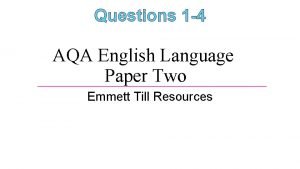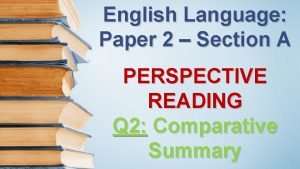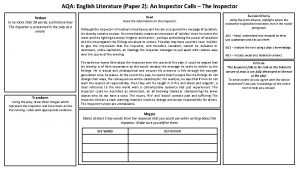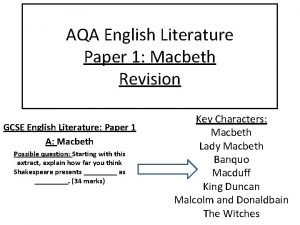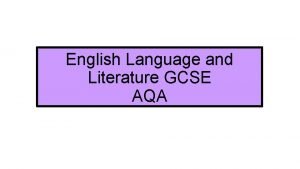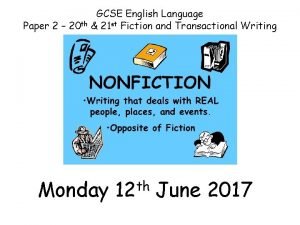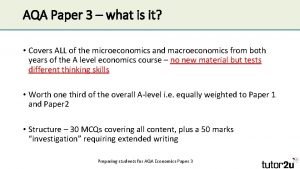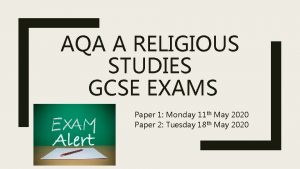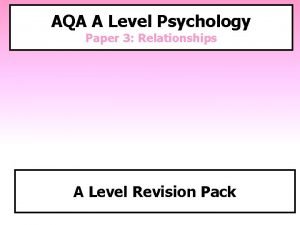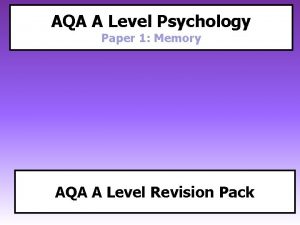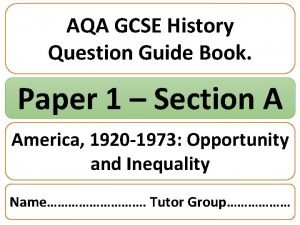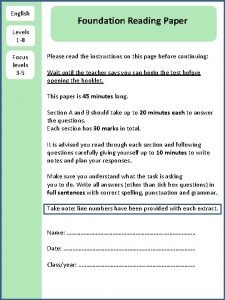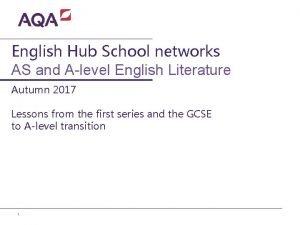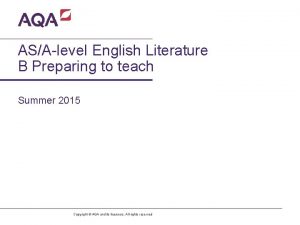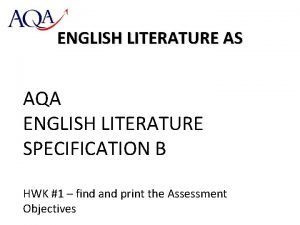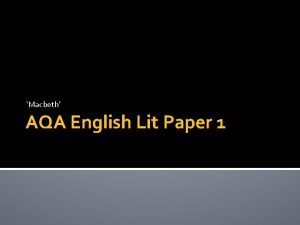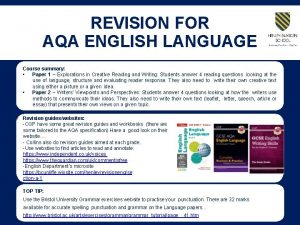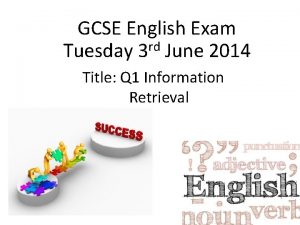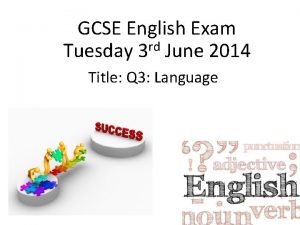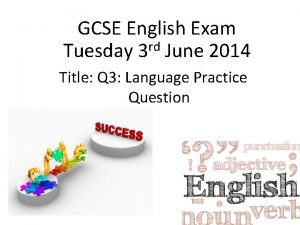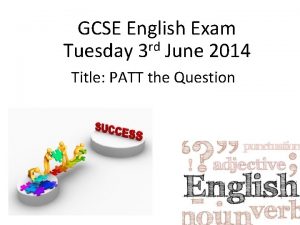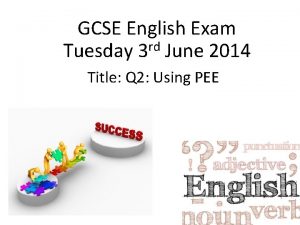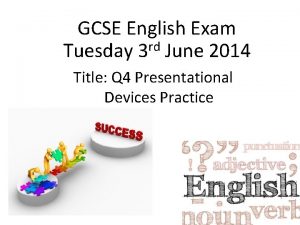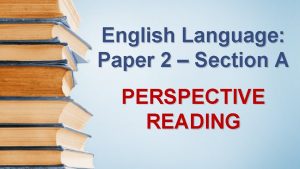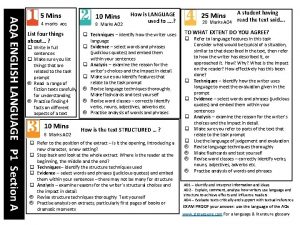AQA Paper 1 English language Section A Reading




















- Slides: 20

AQA Paper 1: English language Section A Reading 40 marks Spend 1 hour


Q 1 – Identify and Interpret List 4 things…. . Marks Given 4 marks Max Time spend: 6 minutes Make: 4 points Identify explicit information Identify explicit ideas • • Underline keywords in the question Read the text & highlight 4 main points linked to the question Out these key points in your own words or quote them Make sure each point is different AO 1 • Identify and interpret explicit and implicit information and ideas • Select and synthesise evidence from different texts.

Q 2 – language Point How does the writer’s use of language… Explain Marks Given 8 marks Max Time spend: 12 minutes Evidence Make approx: 3 -4 points Comment, Explain, Analyse • This question assesses language – words/phrases / language features / language techniques / sentences • Use language terminology • Select relevant quotations • Explain and analyse the effects of the writer’s choices of language AO 2 Explain, comment on and analyse how writers use language and structure to achieve effects and influence readers, using relevant subject terminology to support their views

Q 3 – structure Point Evidence How does the structure… Marks Given 8 marks Explain Max Time spend: 12 minutes Make approx: 3 -4 points Comment, Explain, Analyse This question assesses structural features: • Of the whole text like beginnings/endings: changes in viewpoint • At paragraph level such as topic change/single sentence paragraphs • At sentence level such as sentence length • Use language terminology • Select relevant references from the text • Explain & analyse the effects of the writer’s choice of structural features AO 2 Explain, comment on and analyse how writers use language and structure to achieve effects and influence readers, using relevant subject terminology to support their views

Q 4 – Evaluate texts To what extent do you agree… Marks Given 20 marks Max Time spend: 30 minutes Make approx: 6+ points Make a personal judgement with references to the text • • • You will be given a statement about the text to discuss Write about your own ideas & interpretations of the text Evaluate what the writer has achieved Select relevant quotations from the text Explain and analyse the effects of the writer’s choices AO 4 Evaluate texts critically and support this with appropriate textual references

Paper 1, English: Section B Writing 40 marks 45 minutes Take risks with vocabulary – use impressive and ambitious word choices even if you aren’t sure of the spellings!


Q 5 – Descriptive or Narrative writing 5 mins planning 40 minutes writing 3 -4 sides 24 marks content and organisation 16 marks accuracy Inform – Facts, opinions, statistics, statements, adjectives, subject specific terms, lists Explain – Reasoning, facts, personal opinions and feelings, statement sentences, comparisons, repetition, anecdotes, direct address Discursive markers and Connectives: The reason for, So, The main factor, therefore, when, as a result, moreover, consequently, because, which leads to, furthermore, the consequence of …is… Describe – create a picture or a visual image for your reader – be creative and ambitious with vocabulary choices. Maintain past or present tense throughout Start with: A short or one word sentence A sense (sound/smell/touch/sight/taste) Adverb (‘ly’ word) A complex sentence / subordinate clause A preposition (above, opposite, under, over) AO 5 Content and Organisation Communicate clearly, effectively and imaginatively, selecting and adapting tone, style and register for different forms, purposes and audiences. Organise information and ideas, using structural and grammatical features to support coherence and cohesion of texts.

Spelling, punctuation and grammar: 16 marks Don’t forget paragraphs! No paragraphs – No C grade! Sentence types: Simple/short Compound (and/but/or) Complex Adverb starts (ly words) One word sentences for effect Repetition of sentences and within sentences for effect Punctuation: It must be accurate It must be varied Spellings: There – a place (here and there) Their – belonging to them (it is their cat) They’re – short form of they are (they’re coming to my party) Your – belonging to you (that is your dog) You’re – short form of you are (you’re late again) CAPITAL letters – names/places Commas – after connectives (firstly) and between items in lists Apostrophes – John’s – belonging to John Colons ( ) – introduces lists or reasons Semi colons (; ) link two similar sentences or separate phases Exclamations (!) emphasis Dashes ( - ) creates a pause and additional information Questions marks (? ) even on rhetorical questions Ellipsis (…) creates a pause or a cliffhanger Interrobang (? !) use occasionally AO 6 Technical Accuracy Candidates must use a range of vocabulary and sentence structures for clarity, purpose and effect, with accurate spelling and punctuation. (This requirement must constitute 20% of the marks for each specification as a whole. )

AQA Paper 2: English language Section A Reading 40 marks Spend 1 hour


Q 1 – Identify and Interpret AO 1 List 4 things…. . Marks Given 4 marks Max Time spend: 6 minutes Shade: 4 boxes shaded Identify explicit information Identify explicit ideas • • Underline keywords in the question Read the text Shade the boxes of the statements you think are true Make sure you only shade 4 boxes • Identify and interpret explicit and implicit information and ideas. • Select and synthesise evidence from different texts.

Q 2 – Summarise Write a summary – 8 marks – 12 minutes Identify and Interpret Select and synthesise information from different texts • Underline relevant information in both texts • Interpret this information to answer the question • Show clear connections between the texts • Use relevant quotations to support points from both texts Point from Text 1 with quotation Interpret information Point from Text 2 with quotation Interpret information & make links between the texts AO 1 • Identify and interpret explicit and implicit information and ideas • Select and synthesise evidence from different texts

Q 3 – language Point How does the writer’s use of language… Marks Given 12 marks Max Time spend: 18 minutes Evidence Make approx: 4 points Comment, Explain, Analyse • This question assesses language – words/phrases/language features/language techniques /sentences • Use language terminology • Select relevant quotations • Explain and analyse the effects of the writer’s choices of language Explain AO 2 Explain, comment on and analyse how writers use language and structure to achieve effects and influence readers, using relevant subject terminology to support their views

Q 4 – Compare texts Compare how the writers present… Marks Given 16 marks Max Time spend: 24 minutes Make approx: 5 points Compare writers’ ideas & viewpoints, and how they are shown Devices to compare: Direct address (you/your) Metaphors, similes, imagery Imperative verbs (commands) Hyperbole (exaggeration) Rhetorical questions AO 3 Compare writers’ ideas and perspectives, as well as how these are conveyed, across two or more texts Connectives: In a similar way / in comparison On the other hand / however In contrast / whereas Explanation phrases Suggests / implies / conveys / evokes / indicates

Paper 2: English: Section B Writing 40 marks 45 minutes


Q 5 (6) Argue, Inform, Explain – writing about your own point of view AO 5 Content and Organisation 5 mins planning 40 minutes writing 2 -3 sides 24 marks content and organisation 16 marks accuracy Start with a powerful statement, fact, statistic or rhetorical question You need to present your reader with a clear set of logical ideas about a topic. You need to show consideration of alternative views to your own. TIPS: You MUST use devices throughout your response: Rhetorical questions 3 part list Exaggeration (hyperbole) Comparisons through imagery (simile, metaphor) Emotive language Anecdotes (personal stories & details or a case study) Communicate clearly, effectively and imaginatively, selecting and adapting tone, style and register for different forms, purposes and audiences. Organise information and ideas, using structural and grammatical features to support coherence and cohesion of texts. CONNECTIVES to develop ideas: Firstly, secondly, in addition / Additionally, Furthermore, Moreover, In contrast, On the other hand, Alternatively, Finally, In conclusion Give articles a heading Set out letters the correct way

Spelling, punctuation and grammar: 16 marks Don’t forget paragraphs! No paragraphs – No C grade! Sentence types: Simple/short Compound (and/but/or) Complex Adverb starts (ly words) One word sentences for effect Repetition of sentences and within sentences for effect Punctuation: It must be accurate It must be varied Spellings: There – a place (here and there) Their – belonging to them (it is their cat) They’re – short form of they are (they’re coming to my party) Your – belonging to you (that is your dog) You’re – short form of you are (you’re late again) AO 6 Technical Accuracy Candidates must use a range of vocabulary and sentence structures for clarity, purpose and effect, with accurate spelling and punctuation. (This requirement must constitute 20% of the marks for each specification as a whole. ) CAPITAL letters – names/places Commas – after connectives (firstly) and between items in lists Apostrophes – John’s – belonging to John Colons ( ) – introduces lists or reasons Semi colons (; ) link two similar sentences or separate phases Exclamations (!) emphasis Dashes ( - ) creates a pause and additional information Questions marks (? ) even on rhetorical questions Ellipsis (…) creates a pause or a cliffhanger Interrobang (? !) use occasionally
 Aqa english language paper 1
Aqa english language paper 1 Aqa english language paper 2 rail disasters model answers
Aqa english language paper 2 rail disasters model answers Glastonbury festival and greenwich fair insert
Glastonbury festival and greenwich fair insert English lit paper 1 an inspector calls
English lit paper 1 an inspector calls Paper 1 literature aqa
Paper 1 literature aqa Aqa english literature paper 1 2019 a christmas carol
Aqa english literature paper 1 2019 a christmas carol Human geography revision
Human geography revision Edexcel gcse english language paper 2
Edexcel gcse english language paper 2 Aqa economics paper 3
Aqa economics paper 3 Religious studies 2020 paper
Religious studies 2020 paper Parasocial relationships aqa a level psychology
Parasocial relationships aqa a level psychology Aqa psychology specification
Aqa psychology specification Aqa history gcse papers
Aqa history gcse papers Aqa a level chemistry paper 1 2020
Aqa a level chemistry paper 1 2020 English general paper paper 2 comprehension
English general paper paper 2 comprehension Pre reading while reading and post reading activities
Pre reading while reading and post reading activities English foundation paper
English foundation paper Nea prohibited texts
Nea prohibited texts Aqa a level english literature b past papers
Aqa a level english literature b past papers Aqa english literature specification
Aqa english literature specification English language gcse edexcel
English language gcse edexcel
